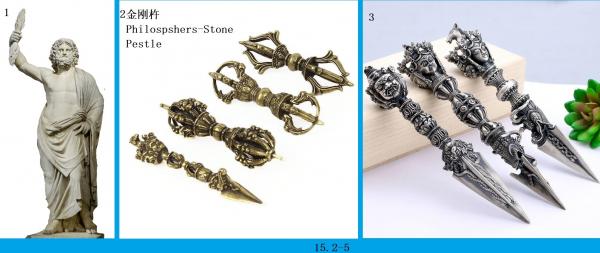| 15.1.1 涅槃果 Nirvana Fruit |
| 送交者: 盧岩 2024年01月27日08:21:58 於 [彩虹之約] 發送悄悄話 |
|
梵語涅槃義為圓滿的寂靜,是苦或煩惱全部被消滅後的身心清淨狀態,故亦名無所有。玄奘法師和弟子窺基在《成唯識論》中從四個方面談涅槃,無餘依涅槃,有餘依涅槃,自性涅槃,和無住涅槃。 Nirvana in Sanskrit means perfectly fulfilled silence, which is the quiet state of body and heart after all bitterness or troubles have been eliminated, so it is also called Empty After All. Tang Tripitaka (aka. Tang Buddha) and his disciple Kuiji discussed Nirvana from four aspects in Establishing Sense-Only Treatise: Nirvana without Residual Dependence, Nirvana with Residual Dependence, Self-Nature Nirvana, and Non-Dwell Nirvana. 一)無餘依涅槃,玄奘說:“真如出生死苦,煩惱既盡,余依亦滅,眾苦永寂,故名涅槃。” 真如即七真如,參見11.6.4節《離系果》。余依,即依之而滅苦的依靠,是依善滅惡的善。余依亦滅,是說善惡兩滅。 1) Nirvana without Residual Dependence, Tang Tripitaka said, “by True Suchness, migrator has ousted bitter of birth and death, the annoyances are exhausted, and the residual dependence is extinguished also, crowds of bitter are forever silent, therefore, the nirvana is named.” The True Suchness is the seven true suchness in the section 11.6.4 Off-is Fruit. The residual dependence, i.e., the reliance by which bitter is extinguished, is the benevolence by which ferocity is extinguished. That the residual dependence is also extinguished, means that both benevolence and ferocity are extinguished. 二)有餘依涅槃,玄奘說:“真如出煩惱障,雖有微苦,所依未滅,而障永寂,故名涅槃。” 障是指異生性的所知障和煩惱障(參見11.4.4.2-4節的異生性)。此說擇滅無為法,即有選擇地消滅了某些根本煩惱,如下文中四種離系果中的前三果,和道諦菩薩十地中的前七地都是選擇性地消滅了主要的煩惱障,所處的境界都是不同程度的有餘依涅槃。 2) Nirvana with Residual Dependence, Tang Tripitaka said, “with True Suchness, migrator has ousted annoyance hindrances, although there is slight bitter, the residual dependence is not terminated, but the hindrances are silent permanently, so it is called Nirvana." Hindrances mean the Know Hindrance and Mean Hindrance of Mutant Nature (see section 11.4.4.2-4 Mutant Nature). This is saying Selectively Termination None-as Laws, such as the first three of the four Off-is Fruits in section 15.2, and the first seven of the ten lands in Path Crux, all are the sates of choosing fundamental annoyances to eliminate, they achieve varying degrees of nirvana. 三)自性涅槃,玄奘說:本來自性清淨涅槃,謂一切法相真如理,雖有客染而本性淨,具無數量微妙功德,無生無滅湛若虛空,一切有情平等共有,與一切法不一不異,離一切相、一切分別(注1),尋思路絕,名言道斷(注2),唯真聖者自內所證,其性本寂故名涅槃。 3) Self-Nature Nirvana, Tang Tripitaka said: “The original quiet self-nature is Nirvana, which is all true suchness of juristic phenomena. Although it is contaminated by guest dusts, its original nature is immaculate, with countless delicate wonderful fortunes and virtues, no birth, no death, and as clear as space, shared equally by all sentient beings, not one and no differences from all laws, free from all phenomena and discriminations (Annotation 1). If you search or mean on it, the road ends, if you call its name or utter words, the path (Annotation 2) is broken. Only the true sage can prove it from within, its nature is inherently silent, hence Nirvana.
注1,涅槃即是微妙本心,是心之常。當人不分別所對的環境,心就停住了,就是涅槃。圖16.1.1-1宙斯手中的就是金剛杵。如圖2所示,是把法的四分(參見11.1節)折合成了兩分,一端是名,包括受蘊、想蘊、行蘊、和識蘊;另一端是色蘊。當名和色相結合,一切法就出現了;當名色分離,就什麼都沒有了,就是涅槃,所以玄奘說 “尋思路絕,名言道斷” ,因為你一尋思,一說話,心就已經又開始工作了,開始分別造作了,根塵就又結合了。 Annotation 1: Nirvana is the delicate wonderful original heart, which is constant of heart. When a person does not differentiate his or her environment, heart stops, which is nirvana. Figure 16.1.1-1 The Philosophers-Stone Pestle is in the hand of Zeus. As shown in Figure 2, the four Juristic Quadrants (see Section 11.1) are folded into two parts. One end is Name, including Acceptance Node, Think Node, Migration node, and Sense Node; another end represents Color Node. When Name and Color are attached, all laws appear; when Name and Color are detached, there is nothing, which is Nirvana. That’s why Tang Tripitaka said, “if you mean and search, the road ends, as soon as you call its name or utter a few words, the path is destroyed”, because once you think or speak, the heart already started to distinguish and create again, the roots and dust are combined again. 注2,道諦講的道理和行為都是根據涅槃的性質而設立出來的,故說涅槃即是道。那這涅槃是存在的,有的,為什麼說涅盤是畢竟空?因為涅槃與空相應,不與有相合,無為法因此而設立。無為法(參見11.6.4節)的無字義即涅槃。一切有為法都與涅槃相違背。什麼是有為法?基於塞斯(即轉移身見),基於有的法都是有為法,例如目前的歐洲文化都是有為法,沒有無為法;再如東方文化的深層都是無為法,有為法很少。 Annotation 2, the principles, and behaviors taught in Path Crux (see chapter 16) are all established based on Nirvana, so Nirvana is Path. Then this Nirvana exists, and have, why is it said that Nirvana is Empty After-all? Because Nirvana corresponds to emptiness and it is not combinable with haves, therefore None-as Law (see section 11.6.4) is established. The word None of None-as represents Nirvana. All Have-as Laws contradict Nirvana. What is Have-as Law? Laws based on Seth (i.e., translocation body view) and haves are Have-as Laws. For example, the current European cultures are all have-as laws, and there is no non-as law; on the opposite, the deep layers of eastern cultures are all non-as Laws and have-as laws are very few. 四)無住涅槃,玄奘說:真如出所知障,大悲般若常所輔翼,由斯不住生死涅槃,利樂有情窮未來際,用而常寂故名涅槃。此涅槃是說此人由於常用集起(參見14.1節)智,所以在他或她的前意識中形成了一個集起的空集∅,就是無住涅槃。如圖15.1.1-4是卡特莉的雕像,她的胸中有個太陽,代表她已經成就了 “無住涅槃” 。因為她是夏娃,是前意識的化身,所以古墨西哥人就把這個太陽畫到她的胸腹里了。插圖3中墨西哥國旗上的鷹就代表着卡特莉,她就是後來的般若(即到達方舟)的作者。 4) Non-Dwell Nirvana, Tang Tripitaka said: “by true suchness, migrator has ousted Know Hindrance, assisted by Great Sorrowfulness and Arrival Ark constantly, therefore he or she does not dwell in nirvana, benefits and pleases sentient beings to the exhaustion of future, usage but constantly silent, hence name of nirvana”. This nirvana means that because the person often uses Aggregate Arousal (see section 14.1) intelligence, therefore there is empty sets ∅ of Aggregate Arousal is formed in his or her preconsciousness, which is the Non-Dwell Nirvana. Figure 15.1.1-4 is a statue of Tlaltecuhtli with a sun in her chest, which means that she has achieved the Non-Dwell Nirvana. Because she is Eve, the incarnation of preconsciousness, so the ancient Mexicans painted the sun (the fourth sun in their legends) into her chest. The eagle on the Mexican flag in Illustration 3 represents Tlaltecuhtli, who is the author of Arrival Ark later. 什麼是大悲?以此墨西哥傳說的《第五個太陽》(參見第18章)為例,墨西哥的後半生都沒能從他神父舍利王(即上帝)的死中恢復過來,常常哭泣;這就是大悲。悲是慈悲喜舍四無量心之一,所以墨西哥(即亞當)力量的主要來源就是他對上帝為拯救人類和眾生而犧牲的悲傷。 What is the Great Sorrowfulness? Take the Mexican legend "The Fifth Sun" (see Chapter 18) as an example. Mexico was unable to recover from the death of his godfather Huitzilopochtli (i.e., God) for the rest of his life and often cried, which is Great Sorrowfulness. Sorrowfulness is one of the four Infinite Hearts of Mercifulness, Sorrowfulness, Delight, and Renunciation, so the main source of strength for Mexico (i.e. Adam) is his sorrow for the sacrifice of God to save mankind and all living beings. ↪️返回第15章《滅諦》目錄↪️Back to Catalog of Chapter 15 Salvation Crux |
|
|
|
|
 |
 |
| 實用資訊 | |
|
|
|
|
| 一周點擊熱帖 | 更多>> |
|
|
|
| 一周回復熱帖 |
|
|
|
|
| 歷史上的今天:回復熱帖 |
| 2023: | “我已經看見了主!” | |
| 2023: | 所羅門的禱告 | |
| 2022: | 如何向長輩傳福音 | |
| 2021: | 如果神的善的,神造的世界必然是善的。 | |
| 2021: | 神預見亞當犯罪,亞當犯罪必然發生。犯 | |
| 2020: | 張伯笠牧師為武漢禱告(轉貼僅供參考) | |




